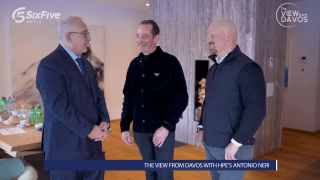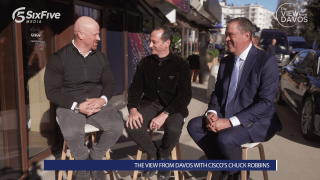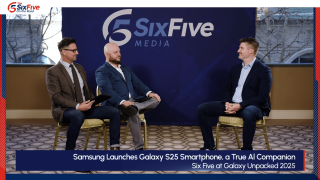IBM provides us with the latest on their AI strategies, from model development to tuning to consulting and implementation. Host Daniel Newman and IBM‘s Rob Thomas, Chief Commercial Officer, spoke on the topics below. ⤵️
- The key drivers behind the current AI productivity surge
- IBM’s role and innovations in advancing AI technology
- Challenges businesses face in integrating AI and how to overcome them
- Future trends in AI development and corporate adoption
- Real-world impacts of AI advancements on different industries
Learn more at IBM and IBM AI4Business.
Watch the video below at Six Five Media, and be sure to subscribe to our YouTube channel so you never miss an episode.
Or listen to the audio here:
Disclaimer: Six Five Media on the Road is for information and entertainment purposes only. Over the course of this webcast, we may talk about companies that are publicly traded and we may even reference that fact and their equity share price, but please do not take anything that we say as a recommendation about what you should do with your investment dollars. We are not investment advisors, and we ask that you do not treat us as such.
Transcript:
Daniel Newman: Hi everyone. The Six Five is On the Road. We are here at the IBM Analyst Forum 2024 in beautiful New York City. Excited to be here a great couple of days talking about the company’s vision, its investments in the future of AI and I’m excited to be able to sit down here with someone that’s been on the show a few times before bringing a lot of great insights, Rob Thomas. Welcome back to the show. How are you, Rob?
Rob Thomas: Great to be here, Dan. Good to see you.
Daniel Newman: It is. Really appreciate your presentation. Enjoyed hearing from you. It’s been a really interesting past 18 months, I can’t believe how fast it’s gone, almost two years since really the-
Rob Thomas: Amazing, right? A lot has happened.
Daniel Newman: The ChatGPT thing came on the scene. But as we all know, you start off with something, I won’t call it a parlor trick, but you start out with something like ChatGPT that’s maybe innovating on search and really consumer centric and now you’ve got enterprises going, gosh, there’s so much potential with GenAI. Give me the little bit of a background now that you’ve had a couple years, you’re processing and all, you’re out talking to customers and building a multi-billion dollar business. What does IBM see as the opportunity for IBM?
Rob Thomas: First of all, thank you for being here-
Daniel Newman: For GenAI.
Rob Thomas: Really, great to host you here. This is our new flagship location in New York City at One Madison, so appreciate you being here.
Daniel Newman: It’s beautiful by the way. Very, very impressive. I’ve been to Astor Place and other places around. This place is very impressive.
Rob Thomas: We love it and we kind of consolidated everything to one place so you can hopefully-
Daniel Newman: Good location too.
Rob Thomas: Yeah, we love it. So thank you. This is an incredible moment around AI. As you said, on the one hand it feels like it’s been forever. On the other hand, it hasn’t actually been that long, but in the 25 years I’ve been with IBM, I don’t ever recall us building a $2 billion business in a period of 18 months, which is what we’ve done. So there is real client momentum to what is happening. I do think we’ve gotten to this point around where the discussion’s all around value creation. People accept the technology, they accept that there’s some exciting things here. But now it’s, how am I going to get value out of this? And I look at it as we’ve gone through experimentation and then you get into things like RAG and fine tuning people start to get some value.
But I would say just in the last maybe three to six months, we’ve hit a bit of a tipping point, which is where there is true ROI coming out of things like IT automation, applying generative AI to code, leveraging assistance, and what’s coming with agents. And the ROI is starting to happen, which is just going to propel the momentum from here.
Daniel Newman: Yeah, it’s been pretty exciting to watch and I am feeling the pivot. Just in the beginning of the year we did some intelligence research on the market and companies were doing a lot of POCs, making big investments. I think there was a 200% growth in companies making multi-million dollar generative AI POCs this year, but there were a lot of concerns about capabilities and competence and I think the industry’s really come together, IBM being one of them, and saying, look, we’re going to think about the technology, but we’re also going to think about design. We’re going to think about implementation. We’re going to put all those pieces together. Because enterprise, it’s complex, it’s not just search, it’s not just language. It’s data sovereignty, it’s residency compliance. And that’s something IBM’s done for a long time. You’re working with enterprise and I think with GenAI we hear a lot about the consumer part of it. And the enterprise part of it, how do you capitalize on this opportunity?
Rob Thomas: Well, the heart of everything we’re talking about is models, and as we kind of looked at the world, this goes back to 2019, our thesis was there’s probably going to only be 5, maybe 10 companies in the world that will actually have the investment dollars and the wherewithal to build foundation models. We are one of those. And we’re really excited with everything that we’re announcing around Granite 3.0. We first brought out Granite at the start of last year. We’re now on the third iteration, and without having models that can drive inference and outcomes and do it at a low cost, we’re not going to realize the value, back to my point on value creation. And so it’s a consistent iteration. In the last six months, we took everything we built in Granite, we put that into open source all under Apache 2 license, and so now people are getting access to Granite without even maybe knowing about it. It ships on Dell servers as an example. I’d say this is our differentiated play in the market that says the cost of this can actually be very low. It doesn’t have to require massive compute capacity to do AI successfully. That’s what we’re doing.
Daniel Newman: Isn’t it interesting how fast it’s happened too? We went from an 8 billion parameter model being what was kind of originally looked at as like a frontier mega model. Just two years later this is what’s kind of considered almost a, very enterprise specific model. I mean, the outcomes, Rob, that you’ve been able to achieve though, and I think one of the things that market probably doesn’t fully appreciate and understand is what you said, if I could double click, IBM is one of the company’s building models and you’re building it with enterprise in mind. And then you’re helping customers because when you think about what IBM’s doing, you’re different in my opinion, I’d like to get your take on this, because you actually build the whole tech horizontally, but then you actually spend time working with customers to make sure they can implement it for their business need for their use case. Talk a little bit about that part of the business because the tech needs implementation.
Rob Thomas: First of all, on the whole stack, to your point, you need to build models. You need a way to orchestrate and manage models. You need what we would describe as AI middleware on top of that. You need assistance, which is how do you actually put a model into a focused application. And so we had built that whole stack. I think what’s unique about our approach to your point is we’re only doing B2B. Our focus is how do we help other companies become more productive using AI? And I think this is where we have an advantage as a company, whether it’s through partnerships we do with other SIs or with our own IBM consulting, we can take all of the theory and put it into practice.
One of the examples I talked about this week was with Vodafone, which is we deployed a team of AI client engineers and in five weeks, five weeks, we took their productivity up 99% in terms of the outcomes that they were getting, looking at documents and then using that to solve customer problems. I don’t think anybody believed 18 to months to two years ago that you could get that kind of value in five weeks. But that is what’s unique about this chapter in the history of AI is you can get an ROI quickly.
Daniel Newman: I sat with Arvind in Davos last year and we talked about this 4 trillion, I think you put a 4.4 trillion, the number’s kind of slowly expanding, Rob. But I mean you also mentioned something in your keynote that I think everyone out there would benefit from, and you talked about customer zero. When you’re a company like IBM, sometimes I think the proof is in the proverbial pudding. Is this technology going to run your business? And it sounds like that’s a big part of your strategy too, is not only Vodafone, great example, but how many parts of the IBM business could benefit from this? Talk about that customer zero strategy just a little bit.
Rob Thomas: I think there’s two benefits here. We did make a decision that anything we build going forward it will be implemented at IBM first. We’re a big company, so it’s a great way to pressure test scalability, usability, you name it. And then after we do that, we will take it to market, and this is actually a big part of IBM’s own value creation story. In the last couple of years, we have taken out $2 billion of cost using AI. We’re using AI to automate HR, automate procurement, automate supply chain, and get into things like sales productivity. But $2 billion hard savings, you can see it in our cash flow, because of AI I think it gives us a lot of credibility talking to clients and saying, we’ve been there and done that. By the way, some of them didn’t go that well at first. We know why that is. We’ve been able to make adjustments as we go. But it’s a big part of our own value creation story. But I think probably even more importantly, it makes our products ready for prime time when we go to clients now.
Daniel Newman: Yeah, so many of those use cases are pretty universal. HR and digital labor and automation use cases, any industry, any business conversation you’d like to have about that is horizontal versus vertical, and of course that’s really, really important. But you also, I mean, Rob, a year ago, I think I sat in one of your analyst days and you were already putting some really compelling case studies and I do the consulting business and the opportunity they have to see efficiency, I kind of call it prune to grow, most of the AI we’re seeing is companies are finding efficiency first and then they’re rocket fueling productivity on the back end. It’s kind of a step function. Sounds like that’s what you’re getting out of the consulting business. Now I want to turn a little bit to your announcements. You kind of teased them a little bit earlier on, but you’ve got some really exciting things you announced here. I’m glad to be able to break it here on The Six Five, but talk a little bit about what you’re announcing from an AI standpoint here at the Analyst Forum.
Rob Thomas: Number one is Granite 3.0 Version. This takes everything that we put into open source before. Our performance metrics are now off the charts. We’re beating Mistral and public benchmarks, we’re beating Llama. Look, these things move up and down, but my point is it’s a proof point that with smaller models, 2 billion and 8 billion parameter, we can perform like 100 billion parameters. That’s a big leapfrog that we’ve done. A lot of this is based on our own invention, things like InstructLab, which is something that we open source, which is all about taking enterprise data and creating model productivity, model improvements.
So Granite 3.0 is the headline, but by having a 3.0 version of Granite, it then flows into everything else. watsonx Assistant is now better. watsonx Orchestrate is now better. What we’re doing around concert, around resiliency, bringing AI to IT resiliency so you can avoid outages, cyber attacks, you name it. So it informs everything that we’re doing in terms of assistance, and this lays the groundwork for what’s coming in agents. We are quickly moving from single tasks performed in an assistant to multitask reasoning with agents. That’s up next.
Daniel Newman: By the way, one of the better explanations because I think a lot of people are sort of conflating assistant agent or automation agent. And then of course that’s the scars, the battle scars of RPA because now we’ve finally got something useful. I mean, to be clear, it was always so rigid and so hard. Automation had a place. But you’re seeing now when you can constantly tune, learn, add AI to those processes, and then of course you can build a whole company, Rob, I’d love for you to just kind of give me your purview on this, but you can build a whole support cast for any role, any function, any BU with agents moving forward. And you’re quickly going in that direction.
Rob Thomas: And really the distinction, another way to say it’s this process versus outcomes. With assistance we basically codify the process. We say this is the process for customer service, here’s Granite and how it informs that, it’s laid out. With agents it’s just about the outcome. I want to improve my retention by 10 points. It’s the agent’s job to figure out how to do that. That’s why I think this is incredibly exciting. I also think it’s more complicated. It will take some time because there’ll be a lot of iteration here. But being able to dictate an outcome and have some reason through the steps to get to that outcome, I mean, this is what the world of B2B software has been looking for forever, and I do think it’ll be very impactful.
Daniel Newman: Yeah, I definitely believe enterprise software there is a coming of age that’s about to happen where a lot of the systems that have historically been used are going to become a bit of a database and we’re going to start to see an abstraction like what you’ve built with Granite different tools where people want to talk to one thing, one abstraction, one pane of glass, and then they want it to go find across all your different databases… Of course, you’ve got your traditional, and then you’ve got all vector now all your unstructured, they want to come back with an answer. They say, hey, look, I want to understand attrition risks over the next two quarters, and you want to go out and find that and bring it back to you. You don’t want to say, okay, I got to go into this CRM, this ERP, I got to go into this… And that’s pretty exciting. I mean, how fast do you see this all coming to fruition? Because I think I saw your curve, it seems you guys have a good handle on the timeline. For everyone out there, how fast do you see this materializing, the enterprise?
Rob Thomas: I think there’s different levels of sophistication. What is very accessible now, and I think it solves every CIO and CTO’s challenge is you can build an AI interface to your applications. Recently, we’ve changed the HR system in IBM.
Daniel Newman: Interesting.
Rob Thomas: Before we did that, we had built an AI interface on top. So not a single user in IBM knows that we changed the back end because their interaction is still with the AI interface. So that is an example of, I’d say, this power of an AI layer on top of your technology. That’s one step. Getting to agents, I think we’ll probably have some interesting things next year and then that we’ll build beyond that. But there are things that are accessible today that enough companies are not taken advantage of, and this opportunity of having an AI interface, digital labor use case that we talked about automating repetitive tasks, there’s huge ROI in this.
Daniel Newman: So as a quick recap, a lot going on here. Big announcements this week, 3.0 Granite, very exciting. Our perspective looking at the overall competitiveness, Rob, is you have a really solid product, or I could call it a solid foundation to build on. And you’re right, benchmarks change. In three months someone’s going to come out with something and then you’re going to come out with 4 and it’s going to change the game. But IBM shows a lot of wherewithal in terms of the whole solution and very impressive what you’ve done with Granite. Congratulations on all this success, and thanks for joining me.
Rob Thomas: Thank you, and I appreciate you being here and all you do.
Daniel Newman: And thank you everyone for tuning into this episode of The Six Five. We are On the Road here at the IBM Analyst Forum 2024 in New York City. Stay tuned, stay with us, subscribe, be part of our community. We’ll see you all soon. Bye-bye.






















































































